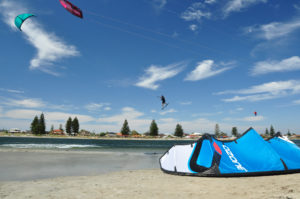How to kitesurf offshore – Minerva Reef
Kitesurfing, Learned something new today, South Pacific, South Pacific Sailing, Tonga — By Kelly on June 8, 2011 10:27 AMLearned Something New Today: How to kitesurf offshore by launching from a yacht!
Before arriving at Minerva Reefs we were unsure if we would have the opportunity to explore the two submerged atolls that belong to Tonga. Discovered in 1829 when the whaler vessel Minerva struck the reef and was shipwrecked for weeks. Our captain said she would only attempt the difficult pass in good weather as the entrance is quite narrow and there are coral head to dodge. We took in the sails the night before to delay our arrival for daylight.
The weather was beautiful the morning of day seven, permitting us to enter South Minerva Reef. We anchored inside the sheltered lagoon for five wonderful days. It was amazing to be anchored in the middle of the Pacific with no land in sight, just reef breaking all around.
The first thing we all did once anchored was jump into the ocean, washing away the dirt that we had accumulated from a week without a shower. The water a gorgeous shade of blue I had never seen … a deep but cool aqua blue, turning into a light turquoise as flowed closer to the reef.
There were five other yachts anchored in the lagoon. On board Kamaya were friend’s of Evi’s, a family from the states, the captain a fellow kitesurfing enthusiast. Tyee III was a large catamaran, on board a family from British Columbia, the parents also kitesurfers.
The five of us had the unique experience of kitesurfing in the middle of the South Pacific, the closest land 200 nm away!
Tom and I were invited to launch our kites from the catamaran, a feat neither of us had ever considered before and were very curious how exactly this would be done. Like most kiters, we had only launched our kites from land where we had ample space to run our lines and never had to worry about our kite hitting a boat. The ability to launch from a boat creates endless possibilities of new and awesome spots to ride.
When you kite in the middle of an ocean, it does not matter which direction the wind blows, so long as it blows hard enough to get your kite into the air. The beloved side shore wind is irrelevant when the nearest shore is hundreds of miles away.
How to launch a kite from a catamaran:
1. Run your lines around the perimeter of the deck beginning at one hull, ending at the other. It is helpful to attach carabineers at each corner to hold the lines in place.
2. Attach a rope with a carabineer on the end on the side of the boat where your lines end (opposite the side with your bar). The rope should be long enough to reach the bottom stair of the hull.
3. Attach the carabineer to your deflated kite
4. Attach the lines to your deflated kite.
5. Pump up your kite (don’t forget to close the valves on the strut!)
6. Wrap one steering line around the closest cleat, so it is shorter than the other three lines taking the power out of the kite.
7. Remove the kite from the carabineer/rope.
8. Have someone bring you your bar as you slowly ease the kite into the water letting the lines slowly drag off the boat.
9. Attach your chicken loop to the carabineer on the rope and position yourself on the bottom stair of the hull.
10. Remove the steering line from the cleat and ensure that your lines are not tangled.
11. Attach the chicken loop to your harness.
12. Get into the water with your board or sit on the bottom stair with the board on your feet and perform a standard water launch.
13. If you need a rest, you can land your kite near the boat and attach your chicken loop to the rope/rope.
The idea of kiting in the middle of a very big ocean where all wind directions equal the dreaded “offshore winds” should had frightened me but I was way too excited by this uniquely awesome opportunity to allow fear to keep me off the water. The reef provided a false sense of security; sort of like an imaginary beach but the reality was that the nearest shore was over 200 miles away.
As a beginner I still struggle to stay upwind and with strong wind speeds, I was overpowered on a 9-meter, my tired legs and arms fought a loosing battle as I dug in my heels trying push myself upwind. I drifted further and further downwind, away from the boats and had to be rescued by a dingy. I was happily kiting downwind when Jon from Tyee and Tom motored beside me in a dingy. Jon told me I should call it a day because at dusk it was now “yum yum time”. Only at that moment did I really consider the fact that sharks live in oceans.]
The experience was by far the most memorable and awesome of my short kiting career and by far the highlight of the passage. Once while on the water I pictured myself as seen from a satellite above, one little kiter girl in the middle of a very big ocean. So cool!
As usual, Thomas was jumping and kiting all over the water, making it look so easy.
When we weren’t kitesurfing, we were swimming, snorkeling, resting, and eating very well. A spear fisherman aboard Cooee caught a five-foot Wahoo that he shared with all the boats. We all came aboard Kamaya for a delicious sushi, fish salad, and fish curry feast. Cyril went out on a kayak lobstering one night but sadly did not bring home any dinner.
The sunsets at Minerva were often a stunning mix of pink, orange, yellow, purple and blue.
As the wind conditions turned favorable for our continued route, Evi decided we should set sail for Tonga, which was still 450 miles away …
To see more photos from Minerva Reefs CLICK HERE.
Read Sailing Adventures in Wonderland for the complete story of the 16-day passage from New Zealand to Tonga.
Tags: kitesurfing, Minerva Reef, reefs, sailing, south pacific sailing, Tonga, Wonderland




























2 Comments
Brilliant Adventure Kelly!
I’m jealous.
D
So glad that you got to visit the reef, I know you were really hoping to go there. 🙂 The pictures are beautiful as usual. I expecially like the one where you are diving and “little girl big ocean”. Have fun and be safe. Love you and miss you.